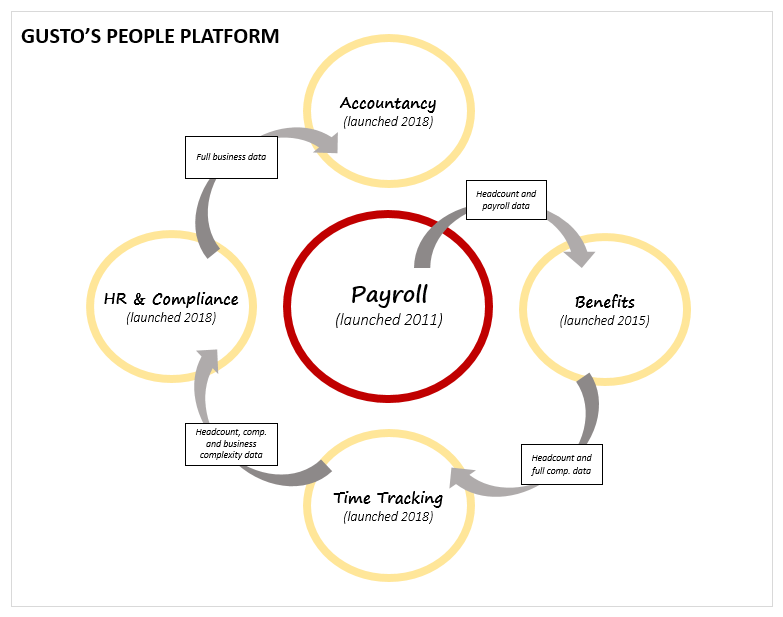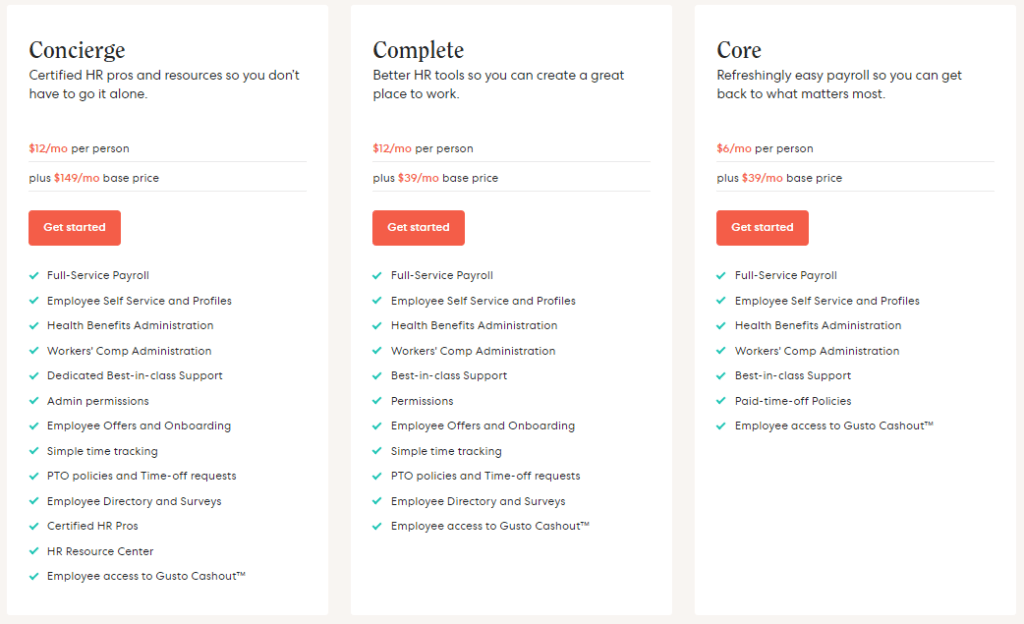Gusto: A payroll software turned ’people platform’?

Gusto began as a payroll software for small businesses, but has since attempted to transform into a ‘people platform’, offering a range services for small businesses (mainly via partners). This post examines the execution and long-term sustainability of this product-to-platform shift.
Humble Beginnings
Gusto was founded in 2011 as ‘ZenPayroll’, a name later changed to Gusto. ZenPayroll’s offering was simple: a cloud-based payroll software to automate all payroll actions (see Exhibit 1). This product was targeted at the c.6M US small businesses– who had been left behind by incumbent software (e.g., ADP). At that time, 31% of small business owners used a manual spreadsheet to process payroll, meaning each cycle was a significant burden[1].
Exhibit 1–ZenPayroll Product[2]
After launch, ZenPayroll’s customer base exploded: from 100 customers in 2013 to 10,000 customers in 2015. They hustled to refine their product: adding the ability to give ‘spot bonuses’, among other features. The product had an impressive Net Promoter Score, a measure of advocacy, of 83/100. Not surprisingly, word-of-mouth helped to propel this growth, with 87% of customers recommending the product to another business owner[3].
New Name, New Model?
ZenPayroll was formally renamed Gusto in September 2015. The rename coincided with the launch of a benefits offering, which included health insurance and workers’ compensation[4]. Gusto’s payroll product gave them a headstart with benefits – as they already had businesses’ headcount and payroll data, so providing a tailored benefits offering was simple.
Since 2015, Gusto has replicated this strategy, leveraging the data created from its platform to launch new platform offerings. They now also offer time tracking, HR & Compliance, among others (see Exhibit 2). The majority of these products are delivered via partnerships (e.g., workers comp. by AP Intego, accountancy by independent accountants)[5]. There are clear cross-side network effects: partners are more likely to participate in the platform if there are a large number of customers, and vice versa.
Exhibit 2–Platform Development
Gusto has created what it describes as a ‘people platform’, which automates the most time-intensive tasks – making Gusto vital to small businesses. They’ve created a virtuous cycle: new platform offerings mean more customers, which mean more partners, which mean more data – and so on.
Execution
I believe Gusto has executed well on its platform strategy to-date. Two strategies standout:
Platform Conversion
Gusto carefully managed conversion of product users into platform users. When launched in 2015, Gusto offered all customers platform access for free – i.e., ZenPayroll customers became Gusto customers and had benefits included in the original price. This naturally drove high conversion, allowing customers to sample benefits. A year later, in 2016, Gusto raised the platform subscription price – reflecting the greater platform value[6].
Gusto repeated this strategy in later years: in 2018, Gusto gave its ‘HR Basics’ offering for free to existing and potential customers[7]. This converted users inside the platform, incentivizing them to try new platform features – enhancing their ‘stickiness’. It also improved conversion into the platform, as it gave potential customers a chance to trial available content.
Payroll Focus
Gusto also smartly maintained focus on its payroll product. In the early days, customers derived some benefit from the additional platform offerings – but payroll was the main attraction point. Gusto continuously invested in the payroll product and rolled out new features (e.g. reporting center in 2017). Per Exhibit 3, the payroll product remains the foundation for Gusto’s pricing plans. This ‘hybrid’ business model (i.e., product and platform focus), gave Gusto time to enhance its platform by using the defensibility of its payroll product.
Exhibit 3–Current Pricing Plans[8]
Challenges
I believe Gusto’s main challenge is potential imitation. There are a plethora of cloud-based HR platforms with similar offerings (e.g., BambooHR/GoCo). One of Gusto’s largest competitors is Zenefits (yes, that Zenefits – see here if intrigued). Zenefits has a similar payroll, benefits and HR platform, but it took a different path: beginning its life as a benefits product[9].
However, I still believe Gusto is best positioned. Their platform foundation, its payroll product, is a more sustainable competitive advantage vs. Zenefits. Payroll customers are less likely to churn and a payroll product produces more informative data – making it easier to effectively expand into new platform offerings. The fact that Gusto started in payroll is their competitive edge – and affords them a sizable lead.
Conclusion
Gusto’s story echoes that of Qihoo. They started with a ‘best-in-class’ product before building a comprehensive platform. They executed the product-to-platform shift well, not losing product focus while driving rapid platform conversion.
Overall, I’m optimistic about Gusto’s future, despite competitive threats – which VCs clearly are too, given they raised $200M in 2019[10]. Their ‘people platform’ is defensible today and they have a long-runway of potential product expansions to make it more so (e.g., employee training, HR advisory services). [749 words]
References:
[1] Business Insider. “Free Snap Payroll App Now Available for Small Businesses”. Retrieved from: https://www.businessinsider.com/free-snap-payroll-app-now-available-for-small-businesses-2012-7
[2] YahooSmallBusinesses. “ZenPayroll Review – Peace Of Mind For Payroll Processing And Taxes”. Retrieved from: https://smallbusiness.yahoo.com/advisor/zenpayroll-review-peace-mind-payroll-processing-taxes-153451109.html
[3] John Brandon. CIO. “Traction Watch: ZenPayroll Experiences 10x Growth In Just Over Two Years”. Retrieved from: https://www.cio.com/article/2916082/traction-watch-zenpayroll-experiences-10x-growth-in-just-over-two-years.html
[4] Igor Gorbatko. Medium. “Growth Story: How Gusto Has Scaled Into a Unicorn-Sized HR Platform”. Retrieved from: https://medium.com/@igorbatko/growth-story-how-gusto-has-scaled-into-a-unicorn-sized-hr-platform-ae6da4a0c714
[5] Gusto. “Partner Resources”. Retrieved from: https://gusto.com/partner-resources
[6] Ken Yeung. VentureBeat. “Gusto raising prices for all customers of its payroll service, starting October 1”. Retrieved from: https://venturebeat.com/2016/08/10/gusto-raising-prices-for-all-customers-of-its-payroll-service-starting-october-1/
[7] Danny Crichton. TechCrunch. “Small businesses love free stuff, so Gusto is giving them free HR basics”. Retrieved from: https://techcrunch.com/2018/03/16/gusto-free-hr-basics/
[8] Gusto. “Gusto Pricing”. Retrieved from: https://gusto.com/product/pricing
[9] Sophia Kunthara. San Francisco Chronicle. “How Zenefits recovered from scandal in insurance business”. Retrieved from: https://www.sfchronicle.com/business/article/How-Zenefits-recovered-from-scandal-in-insurance-13602991.php
[10] Mary Ann Azevedo. Crunchbase News. “Gusto Raises $200M Series D At $3.8B Valuation To Power HR Within Small Businesses”. Retrieved from: https://news.crunchbase.com/news/gusto-raises-200m-series-d-at-3-8b-valuation/





